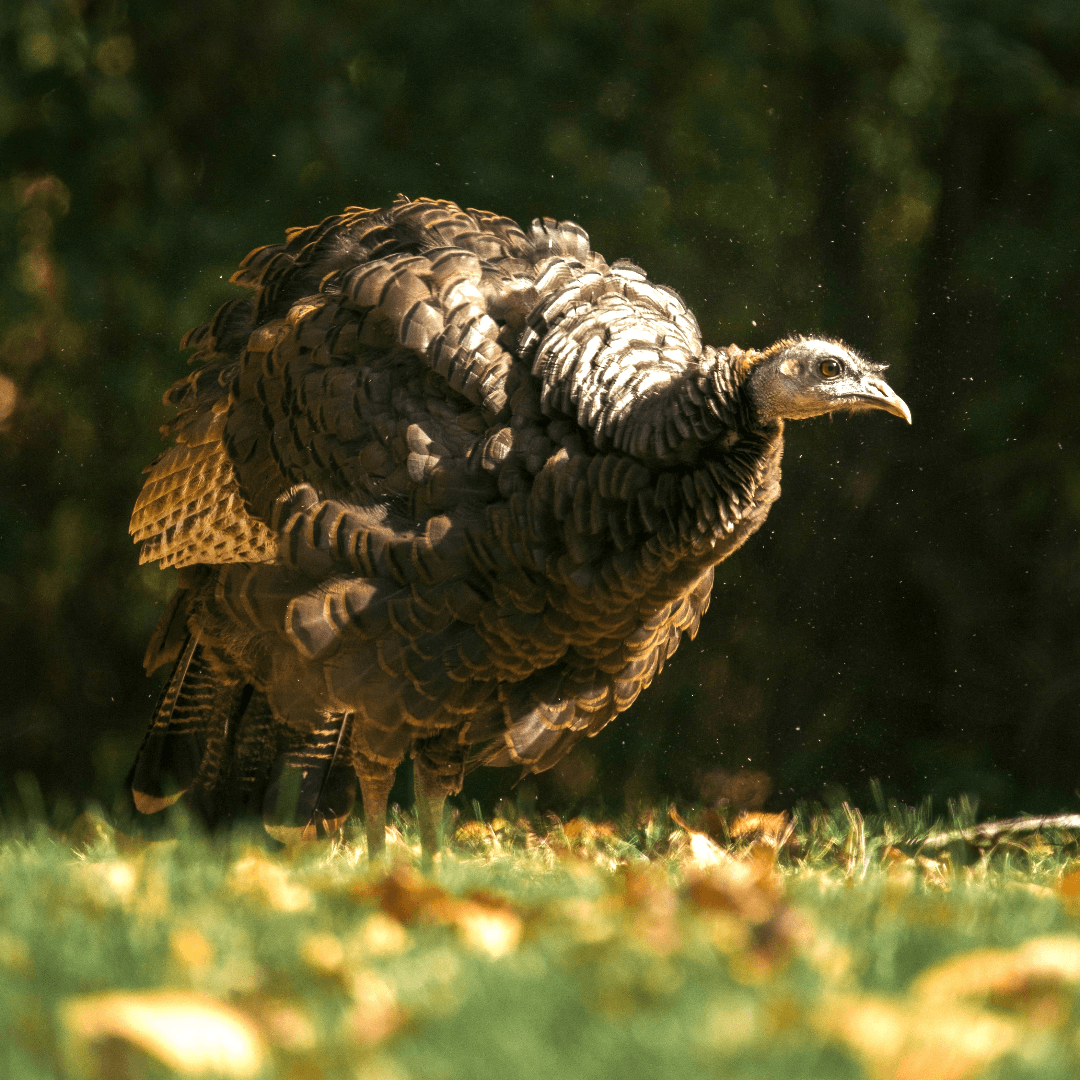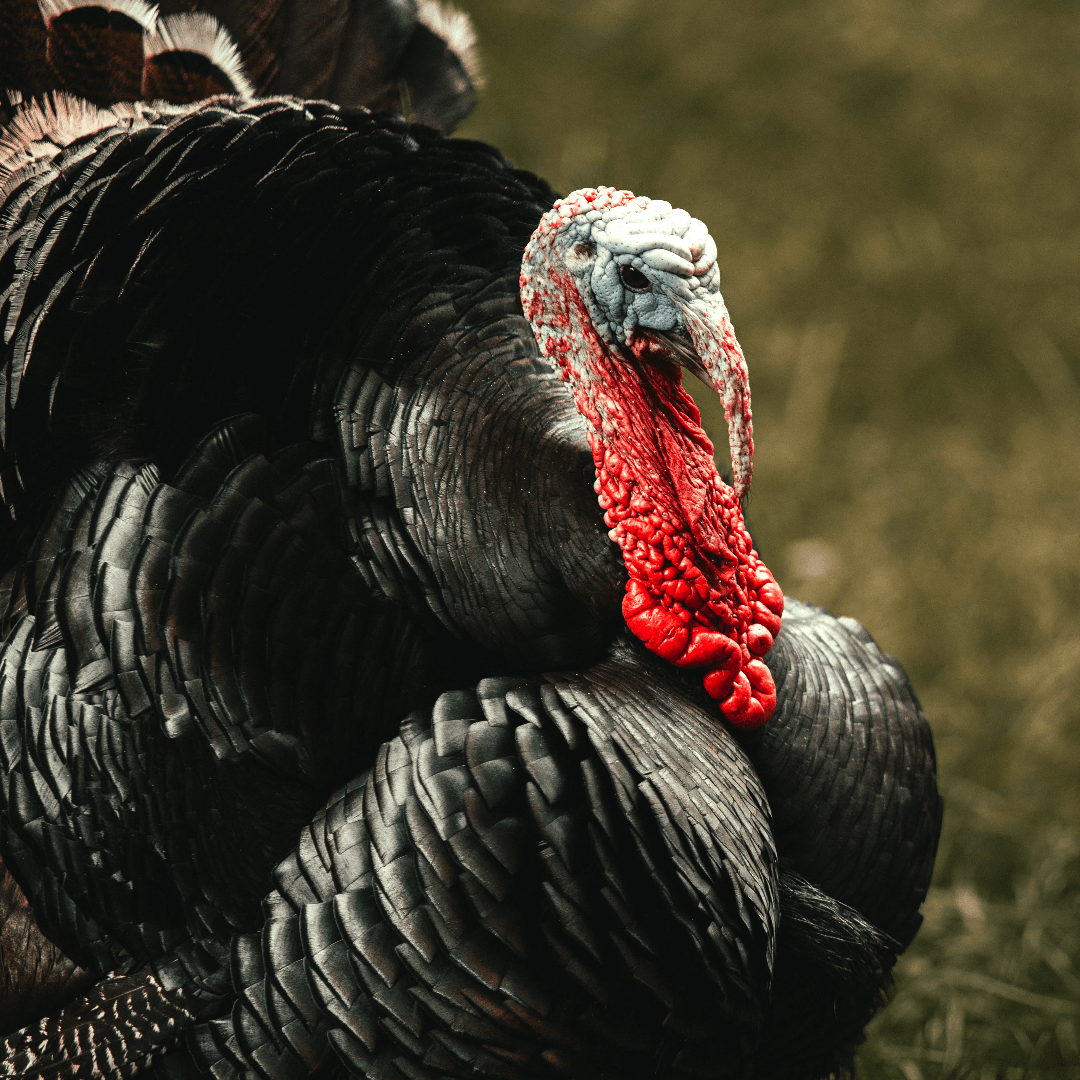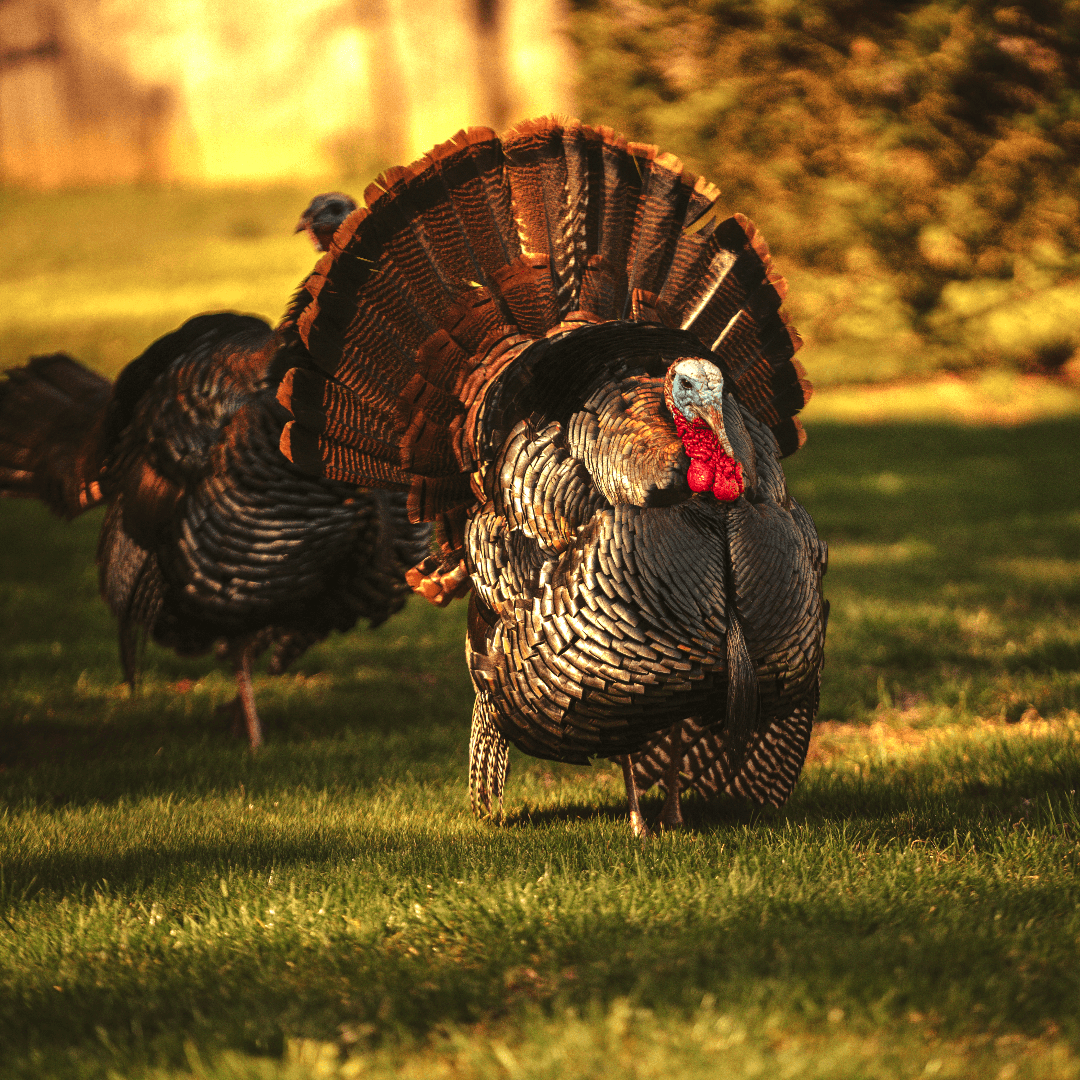Fall marks the season of comfort with its colorful foliage, warming fall flavors, and cozy sweaters. However, unfortunately, this season is not warm and fuzzy for everyone. Every year, close to 46 million turkeys are slaughtered for Thanksgiving alone. We know these social birds are far more than a centerpiece at a holiday table—they’re sentient beings that deserve to live out their natural lives to the fullest. Here are 12 facts about turkeys to warm your heart and make your omnivore family think twice about what’s for dinner. But first, let’s take a closer look at what really happens in the turkey farming industry in the lead up to Thanksgiving.
Are turkeys factory farmed?
Every year, ahead of Thanksgiving, one or two turkeys are pardoned by the President of the United States. They usually look healthy, they have sweet endearing names (like Peanut Butter and Jelly), and the whole ceremony is light-hearted and jovial. But while this tradition makes light of turkey farming, and can make it seem like all turkeys on farms live happy, healthy lives, this is not the reality.
 Ruth Caron
Ruth Caron
In the US, 99 percent of all farmed animals live on factory farms, according to one 2019 analysis, which evaluated data from the USDA Census of Agriculture. The same study noted that one concentrated animal feeding operation (CAFO) can keep roughly 55,000 turkeys. On these industrialized factory farms, the birds are packed in tightly together with little room to move around or express any natural behaviors.
Is turkey farming cruel?
Turkeys on factory farms are often kept in sheds without windows. This type of environment is not supportive of their natural behaviors and instincts; in the wild, turkeys are playful, they are curious, and they like to explore and forage. On industrialized farms, none of this is possible.
This environment can lead to turkeys becoming physically and mentally unwell. They have been known to become aggressive towards each other because of the stress, pecking out feathers, for example. Because of this, many farmers choose to engage in beak tipping, which is when the turkey’s beak is cut in an attempt to reduce injury. Animal rights organization Viva! calls beak tipping a “wholly inadequate and cruel management strategy.”
 Mark Olsen
Mark Olsen
Turkeys are also bred to grow as big as possible, as quickly as possible, so that people can buy big turkeys for their holiday table. Because of their unnatural size, their legs can break underneath them, and they can die from organ failure at an early age.
How many turkeys are killed for Thanksgiving?
Turkey isn’t just eaten at Thanksgiving, but all year round. This means that roughly 245 million turkeys are raised and slaughtered every year in the US. But, of course, they reach peak popularity at Thanksgiving, which is why more than 46 million turkeys die in the lead up to the holiday.
 @foxwithsnacks/Instagram
@foxwithsnacks/Instagram
But there are ways to enjoy a Thanksgiving feast without eating turkey. For ideas, see our guide to The Best Vegan Roasts For Your Plant-Based Thanksgiving or try one of these 18 vegan restaurants that will cook your Thanksgiving dinner for you.
Leaving turkey off your plate is a compassionate Thanksgiving choice. They are intelligent, compassionate, and sensitive animals, and they have a rich and interesting history, particularly in the US.
Turkey facts
To celebrate them, enjoy reading these 12 wonderful turkey facts. (And perhaps keep them in your back pocket for the lead up to Thanksgiving—for anyone who needs a little extra convincing when it comes to embracing delicious turkey alternatives.)
 Suzy Brooks
Suzy Brooks
1 Turkeys were revered in ancient Mexican cultures.
In 300 B.C., turkeys were more than just the centerpiece meal at the table. In fact, Mayan religious imagery depicts turkeys as representations of God, and they are worshiped as symbols of power and prestige. On Thanksgiving, we give thanks for live turkeys—not the ones stuffed with breadcrumbs.
2 The American turkey is named after the country Turkey due to a case of mistaken identity.
An African bird called the guinea fowl (which resembles the American turkey) was brought to Europe through Turkish lands by the Portuguese. Europeans called these birds ‘turkish chicken’ or ‘turkey cock.’ When Europeans saw a similar-looking bird in North America, they thought it was the same fowl and the name turkey cock—later shortened to turkey—remained.
3 Wild turkeys were at the brink of extinction.
In the early 1900s, the population of wild turkeys hit a record low of nearly 30,000 birds as a result of pervasive hunting. Fortunately, effective restoration programs were introduced and the populations recovered. If only all turkeys were allowed to run wild.
 Jonathon Cooper
Jonathon Cooper
4 You can tell a Turkey’s mood by looking at them.
The ability to change color is not unique to chameleons and octopi—turkeys literally show their true colors, too. The skin on a turkey’s head (the snood) and the skin under their throat (the wattle) can change between shades of red, white, and blue depending on how stressed, agitated, calm, or excited they are.
5 Individual turkeys have a unique voice and a wide range of vocalizations.
If you think all turkeys sound the same, science (and the turkeys) beg to differ. Turkeys are able to identify individuals by their voice which is how they recognize one another. Apparently, not all gobbles sound the same in turkey talk. Turkeys have elaborate vocal skills and can exhibit over 20 different vocalizations. Each has a distinct meaning ranging from a cordial greeting to a warning of danger.
6 Wild turkeys can fly short distances but most domesticated turkeys cannot.
Descendants of the wild turkey have been bred into the large, domesticated birds that we see today in order to increase meat yield for human consumption. This unnaturally large size is not conducive for flight. Trim turkeys left to roam and forage on their own are lighter which allows them to take to the air—if only for less than 100 yards.
 Tyler Donaghy
Tyler Donaghy
7 Male turkeys put up an elaborate spectacle to attract a mate.
When it comes to attracting a female, male turkeys put on quite a show! Often called Toms or Gobblers, male turkeys puff up their bodies and spread their tail feathers in a grand display, simultaneously strutting to the sound of their own grunts and gobbles. The more outlandish the presentation, the more irresistible they seem!
8 One can tell a turkey’s gender by their poop shape.
Perhaps save this fact for after dinner, but it’s interesting nonetheless. Female droppings have a spiral shape while those of males are ‘J’ shaped. This has to do with the difference in reproductive anatomy of the cloaca—a one-stop exit for reproductive and digestive purposes. Who knows, this fact could come in handy in an obscure online trivia game.
9 Benjamin Franklin thought turkeys were more majestic than eagles.
If Ben Franklin had his way, America’s national bird might be the turkey. In a letter he wrote to his daughter in 1784, Franklin praised the turkey as “a much more respectable bird” and “a true original native of America.” On the contrary, he wrote that the eagle was “a bird of bad moral character,” “does not get his living honestly,” and is “too lazy to fish for himself.”
 Mikkel Bergmann
Mikkel Bergmann
10 Turkeys swallow stones to aid digestion.
Anyone who has seen Moana may recall her sidekick, Hei Hei, attempting to eat a large stone. While the writers exaggerated the characteristic for comedic effect, there’s actually some truth to it. Turkeys don’t have teeth, so they swallow small stones to help grind up food in their first stomach—the gizzard. Bonus fact: turkeys have two stomachs.
11 Turkeys are highly intelligent and sensitive birds.
Owing to their intelligence, turkeys can remember precise details of an area even after a year of absence. Turkeys also have incredible emotional intelligence. They express empathy for other birds, form lasting social bonds, display affection, and even purr when they feel content and comforted.
 Jonathon Cooper
Jonathon Cooper
12Turkeys have superpowers.
Turkeys have keen hearing even though they lack external ears. Instead, they have small holes behind their eyes and can accurately locate sounds up to about a mile away. The placement of their eyes enables a 270-degree field of vision compared to humans’ 180 degrees. In addition, turkeys have superior color vision and can see UV light!
For more about animals and how to help them, read:
JUMP TO ... Latest News | Recipes | Guides | Health | Subscribe








